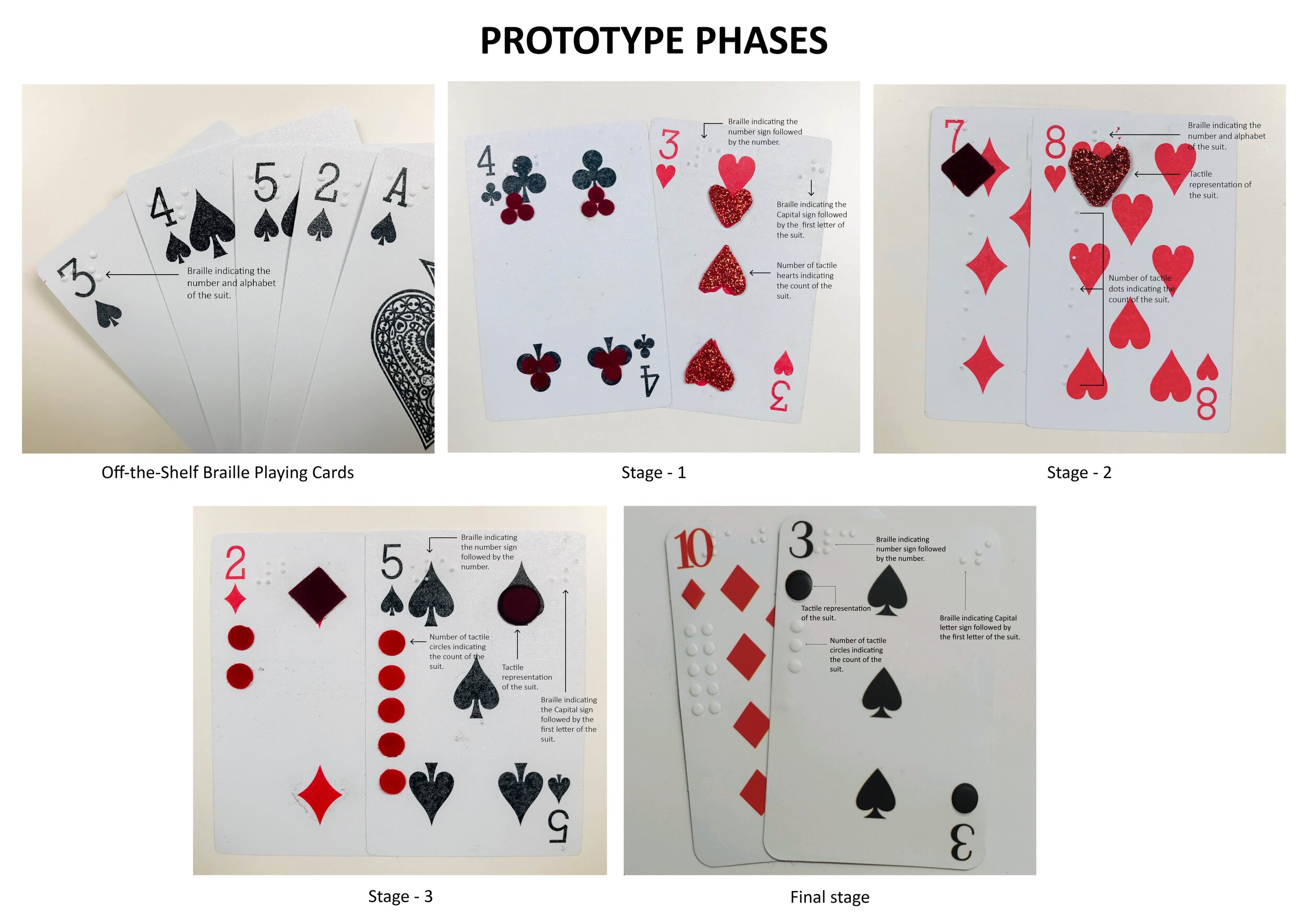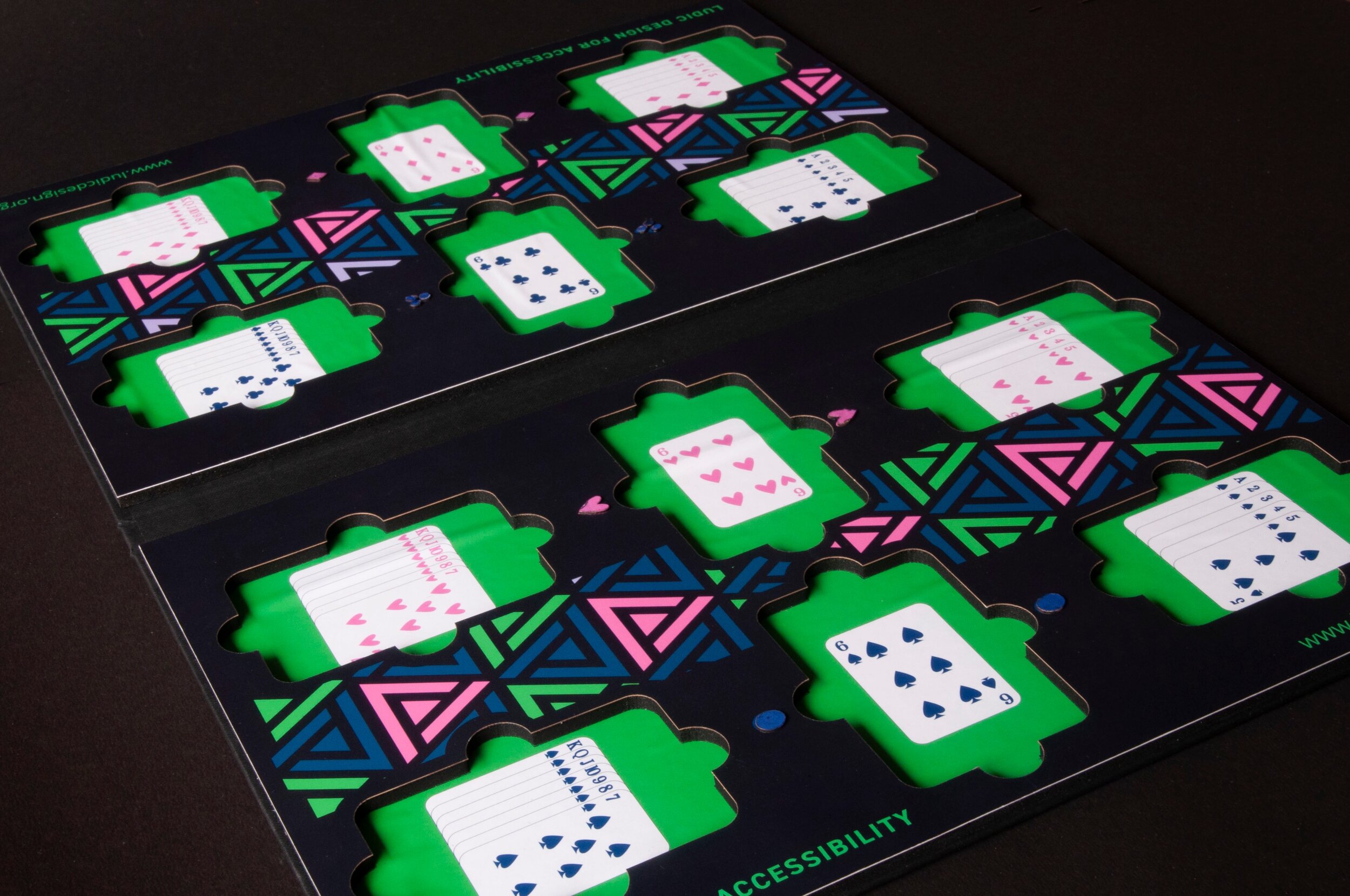The principal purpose of Junior Braille Playing cards is to enhance the numeracy skills for blind children as the side effect through play. Unlike standard playing cards, Junior Braille Playing Cards do not have the picture cards of King, Queen, and Jack. This is done to further simplify the gameplay. However, we have retained the Joker to keep things interesting. The deck has 42 cards in total. Initially, we started by redesigning the playing cards from the available off-the-shelf braille cards. We have made changes and developed in each phase of the prototype.
Apart from the standard printed side, these cards have four tactile elements—a number on the top left corner, the first letter of the suit in the top right corner, a redesigned representation of the suit, and a dotted representation of the number that children can count even if they cannot read braille.
Prototype stages of the Junior Braille Playing cards
To start with, playing cards are generally available in two standard sizes, poker size, and bridge size cards. The Junior braille cards are designed using standard bridge size cards. As the size of the card makes it easier for the children to handle the set of cards in their hands. The junior cards are printed on 300 gms paper- matte finish with round edge corner as the cards avoid slipping away from hand and also avoid paper cuts and they are safe to handle for the children.
Designing suits
Understanding and learning new shapes can be a difficult experience for visually impaired children. They have to be assisted through the shape by guiding their fingers over the outlines of the shapes. The challenge is to design tactile elements that represent the four suits in the card pack so that they can be easily identified.
In this process of designing the suit for the visually impaired, certain factors influence tactile symbols such as the elevation height, size, shape, space, and orientation. The emboss height elevations of the suit are important when trying to identify by touch. The design of the symbols are mainly inspired by basic shapes such as square, rectangle, triangle, circle, etc. The outline of the shape, surface area, negative spacing, curves, sharp edge, scale are also used as purely tactile information to distinguish and identify the shape.It is also important to keep the tactile shape as close to the visual shape so that the names of the shapes like diamond and hearts continue to have the standard meaning.
The tactile colour of the suit helps partially sighted people and sighted people identify colours, shapes and also can interpret the suit by touch.
Re-designed Tactile Suit of the playing Cards for Visually Impaired Children
There were challenges in getting the shapes printed and hence the final shapes were influenced by the chosen printing process. Early feedback from the initial set of users indicate that children were finding difficult in identifying the club suit shape compared to the rest of the other suits in the play cards set.They get confused with the Club design of the suit with the counting dots of the number of the card.We intend to study this further to see if the shapes need to be modified.
Braille:
Braille is a tactile representation of the alphabet, numbers, punctuation, and symbols. Each cell consists of six dots. It consists of arrangements of dots that make up letters of the alphabet, numbers, and punctuation marks. The off-the-shelf braille playing cards are designed with 2 characters in braille on the upper left corner is the number and the upper right corner is an alphabet indicating the suit for VI children to have a clear understanding of the number and alphabet.
Many alphabets and numbers share the same character in braille, the cards might be confusing for young children to read without the number sign and capital letter sign. When indicating numbers, the number sign should be placed before braille numbers to differentiate them from the letter symbols A to J. Same way, the letter sign is placed before the Alphabet to indicate the capital letter.
The braille numbers indicate the number of the playing card and the capital letter indicates the first letter of the suit. Example - Diamond suit is brailled as capital D on the card.
For these braille dots to be represented and checked on digital art-board for embossing and printing, the design is placed with the appropriate size and space-filled circles on the art-board layout. Initially, the circles were constructed from a simple grid of six dots, but the most efficient method of creating braille on the software is with a Braille typeface. This way, the dots of the braille are size adjustable and precise.
Counting through circles:
Number sense refers to the child’s understanding and flexibility with numbers as well as the concept that numbers mean. It varies from each child how they perceive numbers. It depends on the child to explore their own techniques, methods, and strategies of learning through play. This design explores the flexibility of counting numbers and also welcoming the children from easing away with the number. Not every child who is visually impaired knows braille, hence the number of tactile circles are designed to indicate the count of the suit for adaptations for the children who are visually impaired/partially blind.
Play Board :
Play Board For four Children to Play
Scoop Game Play Board
Along with the playing cards come, two game boards—a 4 player board and the Scoop game board. These boards are designed with slots to distribute the cards for each player sitting around it, and central slots to place and collect the cards.
The game boards are important to limit the playing area and to ensure that when all the children who are playing are blind the cards are contained in a structured space. <refer to game 0>
The child can physically explore the board to draw a card from the center of the board for a new turn. Also, through touch, the player will be able to position his/her cards in the slots based on their orientation on the board. The player can then play the appropriate card with an understanding of the sequence of cards that came before.
Thus, the redesigned playing cards have more tactile elements to make the cards more accessible for both the sighted, visually impaired, and braille non-illiterate children who are visually impaired and we have set the stage for a play-centered approach to learning numeracy for VI children. Junior Braille Playing Cards focuses on engaging and empowering visually impaired children through affordable and accessible gameplay.




